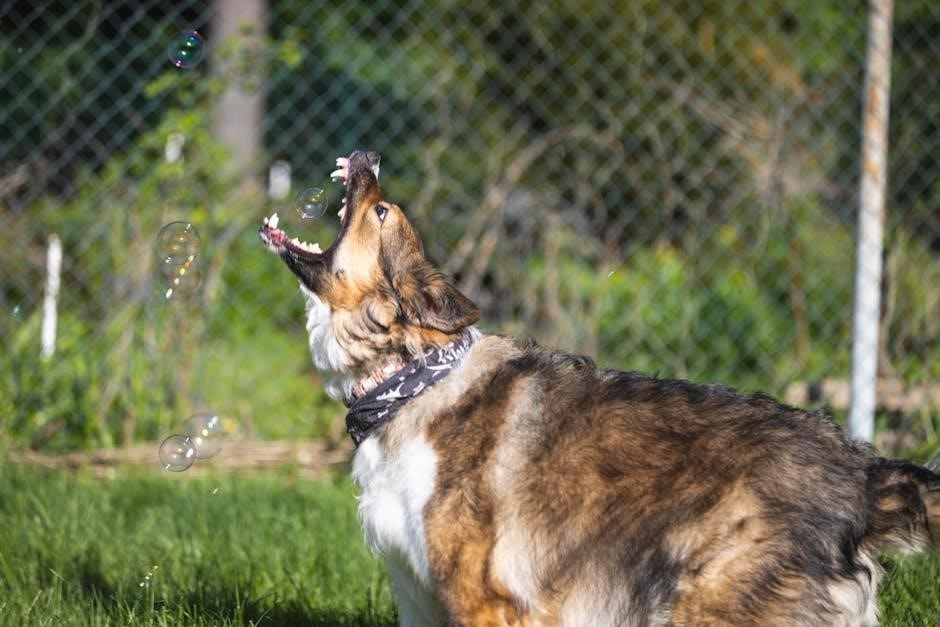Platelet counting is crucial for diagnosing canine health issues, as low or high counts indicate conditions like thrombocytopenia or dehydration. Manual methods ensure accuracy when automated results are unreliable.
1.1 Importance of Platelet Counting in Canine Health
Platelet counting is vital for assessing canine health, as it helps diagnose bleeding disorders and infections. Low platelet counts can indicate conditions like thrombocytopenia or tick-borne diseases, while high counts may signal dehydration. Accurate platelet counts guide treatment decisions, ensuring timely intervention to prevent complications like internal bleeding. Manual counting is often necessary when automated methods fail due to clotting or clumping, making it a critical diagnostic tool for veterinarians. Regular monitoring ensures proper management of platelet-related health issues in dogs.
1.2 Overview of Platelet Function in Dogs
Platelets are essential for blood clotting, preventing excessive bleeding from injuries or internal damage. In dogs, they aggregate at injury sites, forming clots to maintain hemostasis. Platelets also release growth factors, aiding tissue repair. Their function is critical for overall health, as dysfunction or abnormal counts can lead to serious complications. Understanding platelet activity is key to diagnosing and managing conditions like bleeding disorders or thrombosis, emphasizing the importance of accurate platelet counting in veterinary care.

Manual Platelet Counting Procedure
Manual platelet counting involves preparing blood smears, staining, and examining under a microscope to count platelets accurately, ensuring reliable results despite challenges like clumping.
2.1 Blood Sample Collection for Platelet Counting
Blood sample collection for manual platelet counting requires careful venipuncture to avoid hemolysis or clotting, which can falsely lower platelet counts. The jugular or cephalic vein is typically used, and the sample is collected into a tube containing an anticoagulant like EDTA to prevent clotting. Proper mixing of the blood with the anticoagulant is essential to ensure accurate results. Stress during collection may temporarily elevate platelet counts, so gentle handling is crucial.
2.2 Blood Smear Preparation and Staining
Blood smear preparation involves placing a drop of blood on a slide and spreading it thinly with a spreader to create a uniform film. The slide is then air-dried and stained with Romanowsky-based dyes, such as Giemsa or Wright’s stain, to enhance platelet visibility. Staining helps differentiate platelets from other blood components, ensuring accurate manual counting under a microscope. Proper staining techniques are essential to avoid artifacts that could interfere with platelet identification and enumeration.
2.3 Microscopic Examination Techniques
Microscopic examination is a critical step in manual platelet counting, requiring a microscope with an oil immersion lens for clarity. The stained blood smear is examined under high magnification to identify and count platelets accurately. Technicians must use proper focusing techniques to distinguish platelets from artifacts. Factors like platelet clumping or fibrin strands can affect the count, leading to inaccuracies. Ensuring even distribution of the blood film and using a systematic counting method are essential for reliable results.

Factors Affecting Platelet Count in Dogs
Platelet counts in dogs can be influenced by various factors, including platelet clumping, dehydration, and tick-borne infections, which can lead to inaccurate or abnormal results.
3.1 Platelet Clumping and Its Impact on Manual Counts
Platelet clumping is a common issue in manual counting, leading to artificially low platelet counts. This clumping occurs when platelets aggregate, often due to blood sample handling or natural phenomena. In dogs, clumping can significantly affect manual counts, making it essential to recognize and address this issue to ensure accurate results. Proper sample preparation and examination techniques are critical to minimizing clumping and obtaining reliable data.
3.2 Dehydration and Elevated Platelet Count
Dehydration in dogs can lead to an elevated platelet count due to hemoconcentration, where reduced blood volume increases platelet concentration. This condition is often seen in dehydrated patients and is not indicative of an underlying platelet disorder. Manual counts may reflect this elevation, but it is essential to interpret results in the context of the dog’s hydration status. Accurate assessment requires ensuring the dog is well-hydrated before blood sampling to avoid misleading results.
3.3 Tick-Borne Infections and Low Platelet Count
Tick-borne infections, such as ehrlichiosis and Rocky Mountain spotted fever, are common causes of low platelet counts in dogs. These infections can lead to thrombocytopenia by destroying platelets or causing their sequestration. Manual platelet counts may reveal significantly reduced levels, necessitating further diagnostic testing to identify the underlying infection. Treatment often involves antibiotics, and monitoring platelet recovery is crucial. Tick exposure history should always be considered when evaluating unexplained thrombocytopenia in dogs.

Common Disorders Associated with Low Platelet Count in Dogs
Low platelet counts in dogs are linked to conditions like thrombocytopenia and splenic enlargement. Manual counting helps diagnose these disorders, guiding appropriate treatment plans effectively.
4.1 Thrombocytopenia in Dogs
Thrombocytopenia refers to a low platelet count in dogs, often caused by tick-borne infections, autoimmune disorders, or blood clotting issues. Manual platelet counting is essential for accurate diagnosis, as automated methods may miss clumped platelets. Symptoms include bleeding from the nose, mouth, or rectum, and fatigue. Early detection through manual counting helps in timely intervention, improving prognosis and treatment outcomes for affected dogs. This condition underscores the importance of precise platelet count methods in veterinary care.
4.2 Splenic Enlargement and Platelet Sequestration
Splenic enlargement in dogs can lead to platelet sequestration, where platelets are trapped in the spleen, reducing circulating counts. This condition often accompanies tick-borne infections or autoimmune disorders. Manual platelet counting is crucial, as automated methods may underestimate levels due to platelet clumping. Clinical signs include lethargy and bleeding. Accurate diagnosis requires combining manual counts with physical exams to assess splenic size and overall health, ensuring proper management of this common cause of low platelet counts in dogs.

Interpretation of Manual Platelet Count Results
Manual platelet counts help identify normal, low, or elevated levels, guiding diagnoses like thrombocytopenia or thrombocytosis; Accurate interpretation is key for detecting underlying health issues in dogs.
5.1 Reference Ranges for Canine Platelet Counts
The normal platelet count for dogs typically ranges from 150,000 to 450,000 platelets per microliter of blood. Manual counts must align with these reference values to ensure accuracy. Factors like breed, age, and health status can influence normal ranges. Low counts (thrombocytopenia) or high counts (thrombocytosis) may indicate underlying conditions. Accurate interpretation of manual counts is essential for diagnosing disorders such as bleeding disorders or infections. Consistency in testing methods helps maintain reliable results for canine health assessments.
5.2 Clinical Signs of Abnormal Platelet Counts
Clinical signs of abnormal platelet counts in dogs include bleeding from the nose, gums, or gastrointestinal tract. Low platelet counts (thrombocytopenia) may cause prolonged bleeding, bruising, or petechiae. Severe cases can lead to life-threatening hemorrhages, as seen in dogs with critically low counts (e.g., <50,000/µL). High platelet counts (thrombocytosis) are less common but may indicate dehydration or underlying inflammation. Accurate manual counts are essential for identifying these conditions and guiding appropriate treatment.

Role of Manual Counting in Diagnosing Canine Conditions
Manual platelet counting is vital for confirming automated results, especially when clumping or dehydration affects accuracy. It aids in diagnosing conditions like thrombocytopenia and ensures reliable outcomes.
6.1 Comparison with Automated Platelet Counting Methods
Manual platelet counting is often more reliable in cases of platelet clumping or dehydration, which can cause automated methods to undercount. Automated counters are faster but may miss clumps, leading to inaccurate results. Manual counting provides a more precise assessment in such scenarios, ensuring accurate diagnoses. However, automated methods are more efficient for routine testing. Combining both techniques helps in achieving reliable results, especially in complex cases where manual verification is essential.
6.2 Advantages of Manual Counting in Specific Cases
Manual counting is advantageous in detecting platelet clumping, a common issue in dogs with tick-borne infections. It also helps in accurately assessing platelet counts when automated methods fail due to dehydration or micro-clotting. Manual techniques provide a detailed examination, ensuring precise results in critical cases. This method is particularly useful in veterinary settings where accurate platelet counts are vital for diagnosing conditions like thrombocytopenia and guiding appropriate treatment plans for affected dogs.

Tools and Techniques for Manual Platelet Counting
Manual platelet counting in dogs relies on a hemocytometer for accurate cell counting and blood smear staining techniques to ensure precise platelet identification and enumeration.
7.1 Hemocytometer Use in Platelet Counting
A hemocytometer is essential for manual platelet counting in dogs. It provides a standardized grid to count platelets accurately under a microscope. Proper dilution of blood samples ensures even distribution. The grid’s design allows for precise counting, minimizing errors. Regular calibration and maintenance of the hemocytometer are crucial for reliable results. This tool remains a cornerstone in veterinary diagnostics, offering a cost-effective and accurate method for assessing platelet levels in canine patients.
7.2 Staining Methods for Blood Smears
Staining blood smears is vital for manual platelet counting in dogs. Romanowsky-based stains, like Wright’s and Giemsa, are commonly used. These stains enhance the visibility of platelets and other blood cells under a microscope. Proper staining techniques ensure clear differentiation between cell types, reducing errors in counting. Consistent staining is essential for accurate platelet assessment, making it a critical step in manual counting procedures for canine blood samples.

Case Studies and Practical Examples
Case studies reveal dogs with low platelet counts due to tick infections or enlarged spleens. Manual counting helps identify clumping, ensuring accurate diagnoses and targeted treatments.
8.1 Low Platelet Count (Thrombocytopenia) Case Study
A dog presented with severe thrombocytopenia (platelet count: 36) due to a tick-borne infection. Symptoms included lethargy, petechiae, and bleeding episodes. Manual platelet counting revealed platelet clumping, which can lead to underestimation of counts. Treatment involved antiparasitic medication and supportive care, including transfusions and corticosteroids, to manage bleeding. Regular manual counts monitored recovery, emphasizing the need for accurate diagnostics in such critical cases to ensure timely and effective treatment.
8.2 Elevated Platelet Count (Thrombocytosis) Case Study
A dog with dehydration exhibited an elevated platelet count (750,000/µL), a common cause of thrombocytosis. Symptoms included excessive thirst and dark urine. Manual counting confirmed the elevation, with clumping noted. Treatment focused on rehydration and monitoring. This case highlights the importance of manual platelet counting in diagnosing thrombocytosis and underscores the role of dehydration as a primary factor in elevated counts in canine patients.

Best Practices for Manual Platelet Counting
Use EDTA-anticoagulated blood samples and ensure proper staining for accurate counts. Avoid platelet clumping by gently mixing samples. Experienced technicians should perform counts to minimize errors.
9.1 Ensuring Accuracy in Manual Counts
Minimizing pre-analytical errors is crucial for accurate manual platelet counts. Use EDTA-anticoagulated blood samples to prevent clotting and ensure platelet stability. Proper staining techniques enhance visibility under microscopy. Gently mix samples to avoid platelet clumping, which can lead to underestimation. Experienced technicians should count multiple fields to ensure consistency. Avoiding fatigue and maintaining focus during manual counting is essential for precise results. Regular calibration of hemocytometers and adherence to standardized protocols further enhance accuracy in manual platelet counting procedures.
9.2 Avoiding Common Errors in Platelet Counting
Common errors in manual platelet counting include clumping due to improper sample handling, which artificially lowers counts. Overcrowding of blood smears can obscure platelets, leading to inaccurate counts. Inadequate staining reduces visibility, while rushing the count can cause missed platelets. To avoid these issues, ensure gentle mixing of samples, prepare thin smears, and use high-quality stains. Training and experience reduce errors, ensuring reliable and consistent platelet count results in canine blood samples.
Manual platelet counting is vital for diagnosing canine health issues, ensuring accurate results despite challenges like clumping and dehydration, and guiding effective treatment plans for dogs.
10.1 Summary of Manual Platelet Counting in Dogs
Manual platelet counting in dogs is a precise method for assessing platelet levels, crucial for diagnosing conditions like thrombocytopenia or thrombocytosis. It involves blood smear preparation, staining, and microscopic examination. Factors such as platelet clumping, dehydration, and tick-borne infections can affect accuracy. Despite challenges, manual counting remains a reliable alternative to automated methods, ensuring accurate diagnosis and guiding appropriate treatment for dogs with bleeding disorders or other health issues.
10.2 Future Directions in Canine Platelet Counting
Future advancements in canine platelet counting may focus on improving automated methods’ accuracy and integrating AI for enhanced precision. Researchers are exploring advanced staining techniques and digital microscopy to streamline manual counts. Point-of-care testing devices could enable rapid platelet assessment in clinical settings, reducing the need for laboratory-based analysis. These innovations aim to provide faster, more reliable results, aiding in early diagnosis and treatment of platelet-related disorders in dogs.
